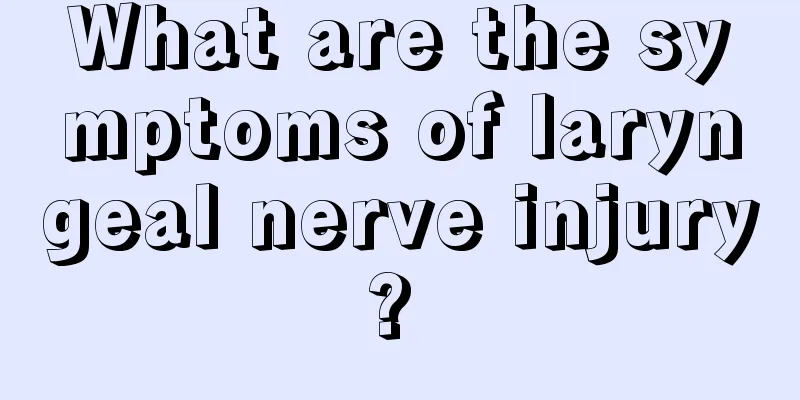What are the symptoms of laryngeal nerve injury?

|
Injury to the internal branch of the laryngeal nerve is a relatively common disease. If the damage caused by this disease is not treated in time, it will affect more parts of the body. At the beginning, it will affect the patient's throat sensation, and the patient will feel discomfort in the throat. The voice of some patients will also be affected to a certain extent. If throat discomfort persists for a long time, patients should seek medical attention and treatment promptly. Due to anatomical relationships, cervical nerve injury often occurs simultaneously with vascular injury. The higher the injury location, the more likely multiple nerves are to be damaged; in injuries to the middle and lower parts of the neck, single nerve damage is more common. Nerve damage accounts for 10% to 15% of combined injuries of the face and neck, among which injuries to the brachial plexus, spinal cord, recurrent laryngeal nerve and vagus nerve are more common. The superior laryngeal nerve arises from the nodose ganglion of the vagus nerve, which is located close to the jugular foramen and divides into internal and external branches at the hyoid level. The external branch often runs closely with the superior thyroid artery on its way down and is generally located in front of the superior thyroid artery. According to Moosman's autopsy of 200 cases, 21% of the external branches had an uncertain direction, 15% were located within the thyroid sheath, and 6% were located between the branches of the superior thyroid artery. According to the observations of laryngeal nerve anatomy by Meng Zhaohui et al. (1976), the superior laryngeal nerve and the superior thyroid artery run closely together, with 89.3% of the nerve running behind the superior thyroid artery, 6.7% in front of the artery, and 4% between the arterial branches. The superior laryngeal nerve arises from the nodose ganglion of the vagus nerve, which is located close to the jugular foramen and divides into internal and external branches at the hyoid plane. The external branches of the superior laryngeal nerve are mainly motor branches that innervate the cricothyroid muscle, and there are also branches to the pharyngeal constrictor muscles and thyroid gland. In addition, before the external branch enters the cricothyroid muscle, it branches out through the lower edge of the thyroid cartilage into the larynx and, together with the anterior branch of the recurrent laryngeal nerve, reaches the thyrotrioid muscle and the lateral cricotrioid muscle. After the superior laryngeal nerve branches off from the vagus nerve, it has a shorter course in the neck and is less damaged than the recurrent laryngeal nerve. It is usually unilateral and is easily injured along with its external branches. symptom A lowered voice is one of the clinical manifestations of superior laryngeal nerve damage. 1. Unilateral superior laryngeal nerve injury The frequency range of speech is reduced and high notes cannot be produced. 2. Bilateral superior laryngeal nerve injury Unable to produce high notes and voice is monotonous. examine 1. Unilateral superior laryngeal nerve injury (1) Physical examination showed that the edge of the vocal cord on the affected side was irregular and bow-shaped. When vocalizing, the healthy side cricothyroid muscle contracts and twists the thyroid cartilage toward the healthy side, causing the healthy half of the cricoid cartilage to be lifted upward. (2) Guttman test: When a normal person applies pressure to the thyroid cartilage from the front, the sound becomes lower; if pressure is applied from the side, the sound becomes higher. When the cricothyroid muscle is paralyzed, the above signs are present on the opposite side. (3) Laryngoscopic examination of unilateral injury shows that the glottis is oblique and the vocal cord on the affected side is lower than the healthy side. 2. Bilateral superior laryngeal nerve injury (1) Physical examination: The vocal cords are wrinkled due to the action of the thyrotrioid muscle. When the fingers are placed on the cricothyroid membrane to palpate the sound, the cricothyroid muscle on the affected side loses the feeling of contraction or traction. When the superior laryngeal nerve is damaged unilaterally or bilaterally, dyspnea and dysphagia will not occur. (2) Laryngoscopic examination showed that the longitudinal tension of the injured vocal cords disappeared and wrinkles appeared on both sides. |
<<: What are the symptoms of insufficient liver and kidney function?
>>: What are the symptoms of emotional dependence?
Recommend
The difference between a baseball cap and a peaked cap
Fashion and clothing are inseparable. Whether a h...
What are the symptoms before death from advanced lung cancer? Several symptoms before death from advanced lung cancer
Lung cancer is not easy to treat, and as the dise...
What are the symptoms of potassium deficiency?
Potassium is a relatively important element in th...
What causes cervical cancer? What are the symptoms of cervical cancer?
For female friends, they are prone to some gyneco...
Sweating while sleeping
Sleeping is a very common thing. Everyone sleeps ...
The reason why ginger grows hair
Ginger is a vegetable with many medicinal values....
The ratio of vinegar soaked banana and brown sugar
Banana is a fruit that many people like to eat. I...
Can drinking more water prevent esophageal cancer?
Can drinking more water prevent esophageal cancer...
What harmful consequences will bone cancer cause
What harmful consequences will bone cancer cause?...
How to care after prostate cancer surgery?
Prostate cancer is one of the most common maligna...
What factors may cause the occurrence of cardia cancer?
The occurrence of cardia cancer is common in life...
How long does it take to get lung cancer if you start smoking at the age of 15
It is impossible to directly determine how long i...
What should we pay attention to when we are concerned about lung cancer? Nursing measures for closed chest drainage after lung cancer surgery
Closed chest drainage is generally performed afte...
How is thyroid cancer treated
How is thyroid cancer treated? No matter what dis...
How often should you wash your face with salt water
There are certain rules to follow when washing yo...









